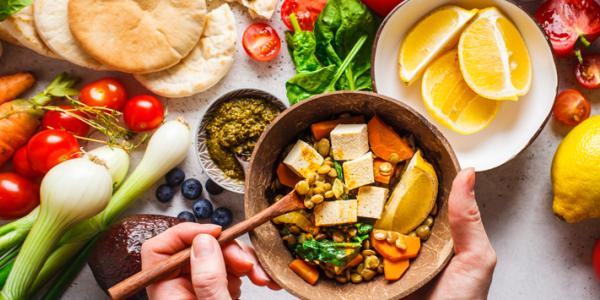The benefits of eating more plants and reducing meat and processed foods are clear: reduced disease risk and improved health and well-being. Specifically, a plant-predominant eating pattern can lower the risk of type 2 diabetes, heart disease, hypertension, unhealthy weight, and many cancers.
Committing to eating more plants does not have to be all-or-nothing. Consider an approach that focuses primarily on vegetables, fruits, whole grains, legumes, nuts, and seeds but is not limited to them.
As you look to add more plants to your plate, keep these eight healthy habits in mind!
Skip
Lean into legumes
Legumes include pulses (e.g., beans, chickpeas, and lentils), soy products (e.g., edamame, tofu, and tempeh), and technically peanuts and peas, too. They are packed with satiating protein, gut-friendly fiber, and anti-inflammatory phytonutrients. Aim to eat a half-cup or more of legumes most days – add beans to salads, snack on edamame, enjoy lentil soup, try a tofu stir fry or explore the world of legume-based pasta.
Give your plate a protein flip
Give plant-based proteins a starring role and serve smaller portions of meat less often. Treat meat like a garnish or flavor enhancer, rather than the mainstay. Plan your meals around vegetables, whole grains and the plant proteins mentioned above, then add in small amounts of animal protein if desired. For example, try a burrito bowl with big scoop of pinto beans and 2 ounces of chicken breast.
Go for dark leafy greens
Dark leafy greens are nutrient powerhouses packed with vitamins, minerals, and fiber. Studies indicate that eating as little as one serving per day is associated with slowed cognitive decline, reduced blood pressure and a lower risk of several types of cancers. Try adding spinach, kale, or collard greens to soups, stews, and smoothies. Add lettuce to sandwiches and wraps, or enjoy a hearty salad with arugula and spring mix for lunch.
Embrace complex carbs, not no carbs
We know that frosted breakfast cereals, white bread, and pastries aren’t healthy foods, but let's not discount carb sources like whole and sprouted grains, sweet potatoes, winter squash, whole fruits, and legumes. These complex, quality carbohydrates retain their fiber and valuable nutrients. They are slow to digest, keeping you feeling fuller for longer, leading to a steady, gradual rise in blood sugar levels for sustained energy. So instead of going no or low carb, focus on incorporating complex carbohydrates while minimizing the more processed options.
Eat fruit frequently
Fresh fruit is the ultimate convenience food at home or on the go. Place a bowl of apples, bananas, and oranges in the kitchen and practice grabbing one for an easy snack or on your way out the door. Add chopped fruit to salads and oatmeal, stock up on frozen fruit for smoothies, or broil fruits like apples or pears until caramelized for a sweet evening treat.
Explore non-dairy alternatives
Start by replacing the cream in your coffee and milk in your smoothies with a non-dairy option. Explore the use of raw cashews in savory cream sauces and sweet treats, and garnish meals with nutritional yeast for a cheesy flavor. Just be mindful of plant-based cheeses and sauces made with coconut oil, which is high in saturated fat and can raise cholesterol similar to full-fat dairy.
Feature fermented foods
Fermented foods are a trend that's research-backed and here to stay! Fermented foods offer valuable probiotics (live microorganisms) that are best known for supporting digestive health. They also support heart health, weight management, and stable blood sugar. To get more plant-based sources, make a dressing with apple cider vinegar or miso paste, add sauerkraut to salads, and add a punch to noodle dishes with kimchi.
Nosh on nuts and seeds
Nuts and seeds are nutritional powerhouses consistently linked with beneficial health outcomes, including reduced risk of heart disease, healthy body weight, and reduced inflammation. Add nuts and seeds as a sprinkle on salads, oatmeal, or buddha bowls. Pair with fresh fruit for a portable snack and try something new with chia seed pudding for breakfast on the go.
This article first appeared in the January 2022 edition of the HealthPerks newsletter.


